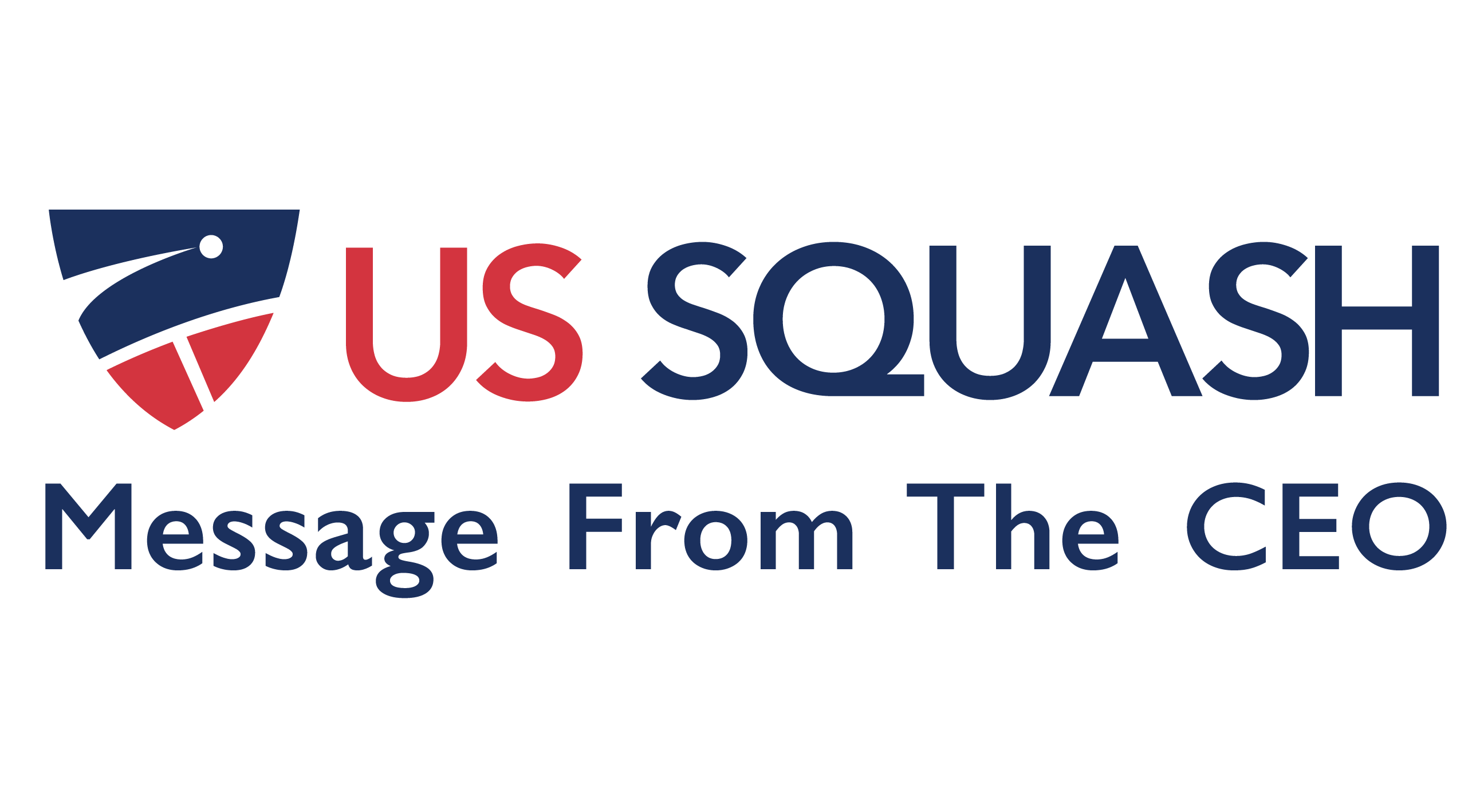
Now that I likely have your attention based on the title, there’s a note about pickleball at the end. Before that, however, I’d like to share some reflections on the last few years leading up to 2022 and look ahead to 2023 and beyond. And if all you really want to know is whether pickleball or squash wins, you can scroll down to the bottom!
During the eighteen years that I’ve been fortunate enough to be President & CEO of US Squash, I’ve often felt like the head coach of a major sports team. All squash players are like the fans of the team—Team Squash—and are not shy in expressing strong opinions about what can be done better. The coach also needs to set the tone, culture and vision; working to inspire others to achieve their best while holding them accountable and leading them to a better way when they fall short. The greatest challenge is to balance the needs of many intersecting groups of constituents, in our case an entire community of those who are passionate about the sport across the nation, and to encourage those with sometimes competing interests to work together.
Like every nonprofit, consistently focusing on our mission is essential. Using our mission as the guide, by orienting all of our actions and investments towards squash’s growth and development, is our path to success.
In 2017, prior to embarking on the final push to make the Arlen Specter US Squash Center a reality (the project had nearly died several times before then), the US Squash Board had significant concerns that were considered, mitigated and addressed through a rigorous process. The priorities identified in this process remain at the core of our focus.
The four priorities, and based on limited resources to be addressed in order to support the others, were:
- build the world’s finest national center
- develop best in class technological infrastructure
- recruit, train and support outstanding teaching pros, coaches and program directors
- dramatically increase access to the sport.
Each of these priorities are roughly equal in how essential they are to the long-term health and development of the sport, as well as the effort and investment required to be successful. US Squash has delivered on the first two priorities and continue to make improvements in those areas; much of our forward-looking focus and investment is centered around supporting the second two priorities.
The world’s finest center
The Specter Center has stepped confidently into its place as the leading facility of the sport worldwide. In its first full year of operation, this beautiful home for squash leaned into a full spectrum of programming from junior and adult play, major competitions and events, new school programs, expansion from our partners at SquashSmarts, and training for U.S. National Team members and other top professional players. Just a week ago it served as the anchor host for the nearly 1000 players from 42 nations at the U.S. Junior Open, and families of these players could watch the competition from anywhere with live streaming of every match from all 18 of the Specter Center’s singles courts.
It’s impossible to cover the breadth of activity that has occurred at the Specter Center in this short space, but I’ll mention a few highlights. We formerly opened the new Peggy & Leo Pierce U.S. Squash Hall of Fame space in April, while we also revealed new exhibits highlighting the impact of scholastic and junior squash, our commitment to the Women & Girls Initiative, and soon, major displays featuring sportsmanship and community in squash. January will see the first teams from the inaugural Philadelphia Public League begin practices and competition, and we are kicking off a partnership with Girls Inc. that will pilot programming that will be expanded in the future to bring the sport to thousands of new girls nationally. National Championships are now back in full swing, with a full plate of junior and adult events coming up; we look forward to hosting thousands of you at the Specter Center in the coming months!
Best in class technological infrastructure
For technology, US Squash has invested significantly in the Club Locker software, a SaaS system that supports US Squash, more than a hundred facilities and their professional coaching and program staffs, 70 live scoring venues and hundreds of thousands of participants involved in US Squash, USA Table Tennis, USA Badminton, and USA Pickleball. Squash Canada also fully leverages the system, bringing these two large and significant North American squash countries in even closer alignment.
Club Locker drives everything we do, from court inventory, database and membership management to all forms of competition and rankings. It allows families or fans to follow results in real time and watch streaming from venues across the country. Participants can self-score and track their progress and results over time. A decade ago, on average a teaching pro would need to invest 40-50 hours in lead up to running a single moderately sized tournament. Now, through Club Locker automation and direct support from US Squash staff of registration, payments, draw seeding and scheduling, communications, score entry and more, tournament directors can focus their time instead on the experience of participants, families and friends.
Increasing access to squash and opportunity
Access means building more courts, which is critical. Though at US Squash, our aims are far broader: access also means the sport being welcoming to people of all ages and abilities: miniaturizing the sport for very young kids, embracing different balls for older players and beginners, and adapting the sport to athletes with disabilities. Of course, it also means making the sport available to people who don’t currently play the sport.
After more than twenty-five years of significant support for squash and education programming by the entire community, the Community Squash model has emerged to addresses access, equity and integration for the entire community. There are 13 US Squash Community Affiliate Network member facilities, many of which include the narrow and deep wrap-around services that the Squash and Education Alliance (SEA) supports. What’s important is that all of these facilities and programs are accessible, in that they are public, affordable, and provide equal opportunities for players to benefit from squash. In facilitating the efforts of local squash communities to develop accessible squash centers that support themselves, we are laying the foundation for our future equitable growth as a sport.
Awareness is a critical first step in access. If you’re not aware of squash, then you’re probably not going to walk into the door even if it is open. So, if you’re wondering why you see pickleball on television all the time and not squash, we are too. Increasing awareness of squash is central to US Squash’s mission, and it is important for us to work more closely with the PSA Tour and to proactively ensure the U.S. media market is fully leveraged as we look to drive real growth.
What we mean by this is 10x growth: increasing the number of regular participants from 150,000 to 1.5 million, and casual participants from 1.4 million to 14 million. To do so we will need to reduce the cost to build courts, pioneer the construction of outdoor squash courts on public and private land, and make a significant push to add public middle and high school squash programs state by state.
Outstanding professionals and coaches
We have been inspired by the perseverance shown by the coaching community as they’ve returned to their important role at the forefront of growing the sport after the broad disruptions caused by the pandemic. We are also fortunate to have so many teaching pros and coaches from dozens of countries from around the world come to the U.S. to practice their trade.
We now offer a myriad of training and certification programs, and additional important requirements are regularly added by the U.S. Olympic & Paralympic Committee, particularly in the area of safety. The Safe Sport program has increased the awareness of child and sexual abuse, and provided valuable training and education to the entire community. Tournament directors also require training and support, as do officials to elevate the refereeing experience for everyone.
Ensuring a safe and quality experience for everyone in the sport, and that a consistent expectation is met or exceeded is a priority. All of these programs, requirements, training, education and certification are being consolidated into the Coach Pass program and managed centrally beginning in 2023. Along with our emphasis on recruiting more women into coaching and teaching roles, we believe continuing to elevate the capabilities of the professional community is critical to our long-term success.
In closing
The community we serve ranges across adult players, juniors, parents, coaches, teaching pros, officials, doubles, women, high school, college, emerging team programs, high performance athletes, board members, district committees and other volunteers, the singles and doubles professional leagues and squash and education programs.
At the Specter Center, we have a Mural Arts Project work painted along the east entrance wall, in which exists a coded message, “A competitive space built on common ground.” The artist Scott Albrecht brilliantly in his summation of all that happens at the center and within the squash community broadly. Squash requires us to occupy the same space, fairly, collaborating in our movement, while competing in the most severe way. It’s simply remarkable and absolutely unique to squash in its elegance, athleticism, endurance and severity. The “common ground” in the artwork is literal in the center, and metaphorical, in our shared values, of courtesy, respect, fairness and personal accountability to name a few.
Finally, I can’t write a year-end message without mentioning the four exceptional women who represented the U.S. in Egypt this month at the WSF Women’s World Team Championships! Our previous best finishes were never higher than fifth; yet in 2022 they reached the final (pushing Egypt hard while doing so). Second place, with a realistic eye towards first in the near future; wow. To Amanda Sobhy, Olivia Fiechter, Sabrina Sobhy and Olivia Clyne—thank you for your commitment and hard work for so long that led to that inspiring performance.
I am looking forward to seeing many of you through the course of 2023!
With warm regards,

Kevin Klipstein
President & CEO, US Squash
p.s. – Oh right, I promised you we’d talk about pickleball. I am often asked what I think of pickleball and its surge in popularity (followed by the person telling me what they think of it). Any physical activity is good for people, and whether that’s surfing, skiing, soccer or squash, it really doesn’t matter. That includes pickleball – which is easy to learn and play, has a built-in court public and private inventory (tennis) and a few billionaires dueling it out to control the explosive growth. It’s a fun game, and has drawn in new people to racquet sports, and leverages the 15,000 trained and certified professional tennis coaches to drive it. While sports participation is not a zero-sum scenario, much of this is and will come at the cost of tennis. Please note, squash has not been mentioned yet, and that’s because pickleball does not compete with squash; it adds to the number of racquet sport enthusiasts (and as a bonus, those who associate racquet sports with vegetables).
What is applicable to squash is to see a takeover of an existing player base and existing court inventory (both from tennis). Racquetball once did the same thing to handball, and now squash to racquetball. 14,000 racquetballs courts (down from a peak of more than 30,000) are quickly disappearing or being repurposed. About one-third of our existing 3,500 squash courts are actually converted racquetball courts; moving quickly and aggressively on this front could be critical to our success.











